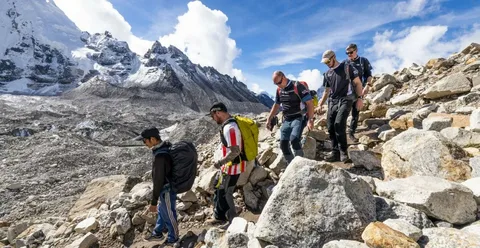That’s what an Everest Base Camp hike is really about: not how many miles you hike or which mountains look cool, but how much joy you can bring to each day and pretty much every step. And that education starts with what to pack. Be you’re trekking up for the first or one-thousandth time, what you have strapped to your back for this mission can make or break the difference between hating your existence and being a total G who acts like the homeboy of the Himalayas.
We need the Everest Base Camp Tour trail to provide versatility, convenience, and responsibility. You will slog through variable weather, challenging terrain, and rudimentary housing. Overpacking could serve as a ballast; underpacking, a case of forgetting a need. Here’s how to achieve that balance and how to pack for one of the world’s great treks like a pro.
Think Layers, Not Bulk
It’s the type of place where you can wake up to clear, ice, nd beautiful weather, and within a few hours of your first coffee, we get swallowed by fog-bound and stormy weather. That is why the name of the game to staying relaxed isn’t always massive or heavy gear, but is set layering clever.
Don’t wear cotton — it retains moisture, dries slowly, and if you cool off, cotton has very little opportunity to retain warmth. Anything between those and merino wool or synthetics is a hundred times better.
You unzip or shed a layer,e r, you hang on till the next hill, pull on a jacket when you drop down again, into the cool of a valley floor, or are just breaking for a snack on the trail.
Choose Your Footwear (And Break It In)
Chances are, your boots will be the most important things you pack. You’ll have them on all day, every day, for hours at a time, hiking over rock trails, along suspension bridges, and some days walking on snow trails. Bring With You At Great Quality Waterproof Hiking Boots With Ankle Support -Break In Your Boots Before Setting Out On The Trail.
Stat: You can’t wear new boots on a hiking trail without breaking them in, or you’ll end up with blisters, black toes, and a lot of hurt. Train in the shoes you’re going to race in, so they fit your foot like a glove and don’t even feel like they’re there. Step 4: Pack 3-4 pairs of moisture-wicking, cushioned hiking socks and at least one pair of thin liner socks to reduce friction.
Bring a pair of lightweight camp shoes or sandals to wear at the tea house nights. Your feet will thank you.
Pack Light, But Don’t Skimp
Everest Base Camp Hike If you’re not carrying your pack, or some local is lugging your duffel bag from one end of the earth to the other — however heavy and clunky your pack, it shouldn’t be packed like you’re riding bumper cars — everything, everything in that pack should serve a purpose, and should be light and essential. The golden rule: only take what you need and nothing more.
Offer for pre-boarding official-agent services. Only packing. You only need to pack a few pieces of clothing that can be layered and worn more than once. 2 x trekking clothes is even adequate, and on rest day, there is always laundry to wash. Throw in one sleep outfit (it’s cold at night) and another clean shirt for that first night after it’s all done, in Kathmandu.
Take along quick-dry panties, gloves, and a warm hat, a buff or neck gaiter. Up top, have eye consciousness: Good sunglasses that protect against UV, especially on the snow-capped trails, up high.
And don’t forget sunscreen and lipscreen (a.k.a. a lip balm with an SPF) — the sun can burn through clouds ferociously at altitude.
Looking & Feeling Great While Sleeping In The Bag
If the nights in tea houses or inns are frigid on the Everest Base Camp trail, Namche is the exact opposite, and it is at a lower elevation. A -10°C to -15°C, 4seasonsn, sleep bag as a minimum.
Some tea houses will offer blankets, some not, and especially when temperatures dip below freezing, but you always want to have the comfort of your sleeping bag to warm you up. A compression sack protects your sleeping bag’s shape in a duffel.
Organize for Efficiency
When packing, organization is everything. I organize with packing cubes or dry bags because this allows me to easily keep all of my gear types separated (clothes, toiletries, first-aid, electronics, etc.), each survival kit contents is listed on the exterior of the bag in multiple languages so you can look at the bag and quickly determine if you have everything you need and quickly find what you need, even when you are packing in a poorly lit room and tired.
— Daypack: A 20-30-liter daypack to take on daily hikes outside. That should take care of most of what you need it to for the day — your rain gear, camera, snacks and sunscreen, water bottles, and extra layers. Porters generally pack the duffel upright and retain a single daypack, which acts as your intermediary.
Hydration and Water Safety
Add hydrating by 34Ll per day to your list of empty hour activities… Keep well hydrated: 3–4l. To help ward off that pesky altitude blowback. But quaffing raw water when you’re on the trail can be unsafe, so tote a system that lets you purify as you go.
Water purification tablets, a UV wand (like SteriPen), or a filtered bottle can work wonders. Hydration bladders — the CamelBak system is a solid one —are also light, easy to suck water out of as you trudge along if you’re on foot (don’t let the tube freeze at high elevations), and the system doesn’t weigh that much. Bottles work best higher than about 4,000 meters.
Essential Extras You’re Sure to Be Glad You Packed
Every little bit helps. You’ll want a headlamp for those early morning calls and getting to dark tea houses. Use an electricity financial institution to power your phone or camera (power is spotty and steeply priced at high altitudes). Wipe down: Wet wipes and hand sanitizer can help you clean up and avoid a daily bath.
Convey a primary first-aid kit, inclusive of altitude meds, blister medications, painkillers, and digestion aids. You gained’t need trekking poles, but you’ll be glad to have them to stabilize yourself going down steep downhills and save your knees.
Don’t tour without your passport and hiking gear — shop them in a waterproof pouch to shield against precipitation.
Final Thoughts
There is no right or wrong answer to what to pack for Everest Base Camp, just getting your priorities straight. The right gear not only helps keep you warm and dry — it frees you to revel in the conditions, to concentrate on the experience of the moment, without thinking about when the heck you might be able to go in.
When you pack like a boss, you are not unsure. You’re ready to soak in every sunrise, stampeding herd of elk, roaring waterfall, or scenic overlook, while you’re perched and confident. Behind the door? The Himalayas, and a front-row seat to them: Pack smartly and walk in.



